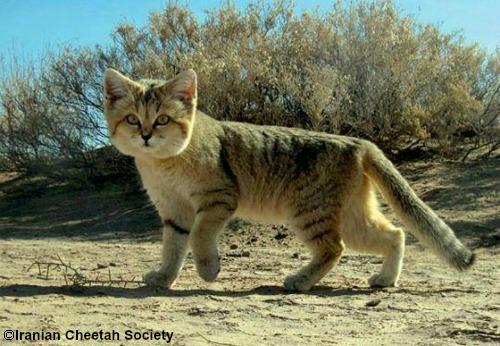
- HB Length: 39-52 cm (15-20″)
- Tail Length: 23-31 cm (9-12″)
- Height: 24-30 cm (10-12″)
- Weight: 1.3-3.4 kg (3-7.5 lbs)
- Pop. Trend: Unknown
The Sand Cat Felis margarita is a true desert dweller and are the only felid to occur exclusively in desert habitat. They have numerous adaptations to an arid life and colouring that blends in with their environment.
The coat is soft and dense, mostly pale sandy brown to light grey, slightly darker on the back and whitish on the belly. A reddish streak runs across each cheek from the outer corner of the eyes; the lower half of the face and chest is whitish to pale yellow. The tawny reddish ears are black tipped, as is the tail, which also has a few narrow black rings near the tip. The broad head has large eyes placed greatly forward, and low set, large, tapered ears which provide keen hearing for habitat where prey is scarce.
There are pale cross stripes running down the flanks, almost invisible until the legs are stretched out, and indistinct bars on the limbs. Another desert adaptation is the long, dense, hairs covering the soles of the feet, providing insulation from the hot sands and helping them move across shifting surfaces. They have evolved a thick coat which insulates them from the alternating intense heat and cold of a desert environment.
Distribution

Sand cats occur across the Sahara Desert, from Morocco in the west to as far as Egypt and the Sudan in the east. In Asia, they have been recorded in Syria, Iran, east of the Caspian Sea in Turkmenistan, Kazakhstan and Uzbekistan. Their presence in Pakistan is unknown. Sand Cats show a scattered distribution across the Arabian Peninsula but their status and distribution are not well known.
The global distribution of the Sand Cat appears to be markedly patchy. It is not clear whether the gaps in known range are due to a lack of records or truly reflect species absence.
As true desert specialists, they occupy areas that receive less than 20 mm of rainfall a year. They inhabit a variety of sandy and stony desert habitats with some cover, and arid shrub-covered steppes.
The first radio telemetry study on these little cats (1993) was in Israel, where biologists discovered they were extremely difficult to track. The fur on the soles of their feet that prevents them from sinking in soft sand also makes their tracks almost invisible. When a light is trained on them, they crouch low, closing their eyes so that no reflection is visible. This behaviour, along with their excellent protective colouring, compounds the problem. The cats also buried all their feces, making it impossible to gather data about their diet.
Home range sizes likely vary according to ecological conditions and vegetation cover available for prey animals. In a study along a dirt road in southern Morocco, initial home ranges of two males and one female followed during four to six days were 35.3 km², 21.8 km² and 13.4 km², respectively. A radio telemetry study in Israel suggests large home ranges, with one male using an area of 16 km². Seven annual ranges in Saudi Arabia, were estimated at 19.6-50.7 km² .
Sand Cats have been recorded to move long distances in a single night. In Morocco, one male travelled more than 14 km in a straight line in less than 30 hours.
Ecology
Sand Cats are prolific diggers. Digging is necessary to construct and improve burrows, and dig rodents out of the sand. Their claws do not fully retract and are not very sharp, as there is little opportunity to sharpen them in the desert and they are likely blunted by digging.
When crossing open spaces they keep low, skulking on bent legs. The low set ears enable stalking among rocks with a minimum of exposure. Because the hot dry air of the desert absorbs sound, large ears are required to pick up the faint squeaks of their prey. Their prey provides most of their moisture requirements, as they inhabit generally waterless regions. They will drink water if it is available but can survive on the moisture received from their prey. Enemies include venomous snakes, jackals and large owls.
In the Sahara they are known as ‘the cat that digs holes.’ Among Saharan nomads, Sand Cats have a reputation for being snake hunters, particularly of horned and sand vipers, which they stun with rapid blows to the head before dispatching with a neck bite. They also cover large kills with sand and return later to feed.
Primarily a nocturnal animal, they spend the hot daylight hours in a shallow burrow dug into a dune or beneath a shrub. They use and enlarge burrows of other species, as well as digging their own. They have occasionally been observed above ground in daylight near their burrows, lying on their backs in a posture to shed internal heat. Dens are used by different individuals, but not at the same time. At nightfall, they take up a lookout position at their den opening, and survey the surrounding area for about 15 minutes before leaving. They are active throughout the night, hunting and travelling 5-10 km. Before retiring below ground at dawn, the same lookout position is adopted at the mouth of the burrow.
Sand Cats are solitary animals with a very low population, and make use of a loud mating call, much like the barking of a small dog. The loud barking, combined with excellent hearing, enables these cats to find each other over great distances. Other vocalizations include mewling, growling, spitting, hissing, screaming and purring much as in domestic cats. Grooming and defense behaviour is also similar to domestic felines.
Reproduction
Breeding in the wild is seasonal with births born January-April. After a 60 – 67 day gestation, one to eight – usually 3-4 – kittens are born annually in a burrow or among rocks. Weight at birth is 50 – 60 grams. At two weeks their eyes open, they first venture outside at three to four weeks, and eat their first solid food at five weeks. They become independent at three to four months, and sexual maturity is reached at about 9 – 14 months. They have lived to 18 years of age in captivity.
Conservation
Habitat degradation and loss are considered to be the major threats to the Sand Cat. Vulnerable arid ecosystems are being rapidly converted by human settlement and activity, especially degraded through livestock grazing. Additional threats are the introduction of feral and domestic dogs and cats, creating direct competition for prey, predation and disease transmission. This applies particularly along roads through suitable habitat.
In Iran, Sand Cats are killed by shepherd dogs and trapped in snares set for other species. They also get stuck in fences and are vulnerable to indiscriminate trapping and poisoning of predators.
In the Arabian Peninsula, sand dune habitat continues to decline. Several of the areas have been affected by political strife, and war-like conditions that have accelerated habitat destruction i.e. Syria.
Locally, Sand Cats may be threatened by the pet trade. There are occasional reports of Sand Cats being shot in Saudi Arabia.
In Algeria, they are not considered a threat to poultry, or trapped to sell as pets. Toubou nomads living northwest of Lake Chad consider Sand Cats frequent chicken thieves which readily enter their camp in the evenings. They do not generally retaliate, due to traditional religious respect for these small cats as tradition holds that they were the companions of the Prophet Mohammed and his daughter.
The development of reliable survey methods is urgently needed to assess the population. Furthermore, studies on the behaviour and ecology of the Sand Cat are crucial to apply appropriate conservation measures.
Range Map IUCN Red List (2016)
Updated 2017

Pat Bumstead
It is very difficult to distinguish the different species of sand cat. Their location is generally the best clue to decide if they are Felis margarita. F harrisoni, or F thinobia. Zoo animals are often not identified by species for various reasons.
Nils
Hello, how does one differentiate an Arabian sand cat from a Saharan sand cat? I heard that Arabian sand cats have 2-3 rings on their tails and greyer fur color, but photos on Wikipedia do not seem to match that description. Is WP wrong or am I missing something? Thanks!
Pat Bumstead
I have sent your comment to a sand cat researcher but he is out of the office for just over a week. One of us will get back to you then.
Dakshina Marlier
Hi! I’m a field biologist by training, but also archaeologist documenting archaeology for NEOM in Northern Saudi Arabia west of Tabuk. Since I’m seeing lots of wild cat prints in sand dunes, if there’s more info as to what sand cat prints MIGHT look like (as opposed to Caracal) in wild dune habitats, we’ve been seeing small burrows and wildcat scat as well. If we can help add any information, this is for a future development project so would be good to be able to accurately document any good info! If you have any resources we could use for ID, thanks in advance!
Pat Bumstead
Yes sand cats are listed as Least Concern. This is because their population is scattered across northern Africa and the Middle East. No one knows how many animals there are out there as they are impossible to research in an area that large.
Pat Bumstead
Yes sand cats are classed as Least Concern by the World Conservation Union. The reason for this is that their population is so scattered over so many countries in northern Africa and the Middle East, and no one knows how many sand cats there are in the wild. A few sightings have been made in various countries but the population had never been studied as a whole.
Natalia
hi! i’m doing my speech on sand cats and just finishing it off.
but I wasnt sure for something…I swear I saw somewhere that sand cats are on the least concern list. is this true? I ain’t so sure.